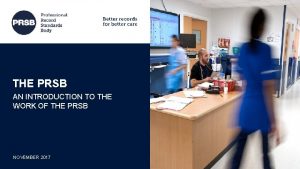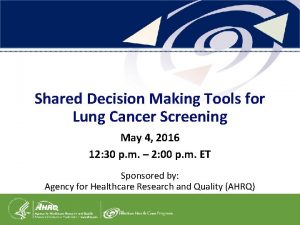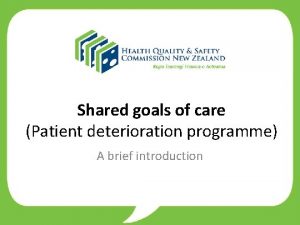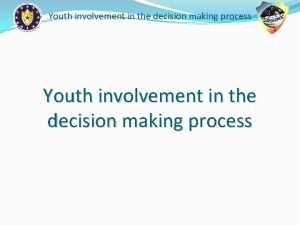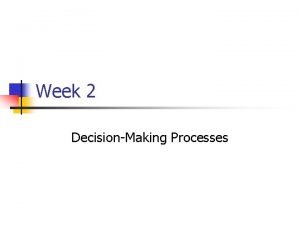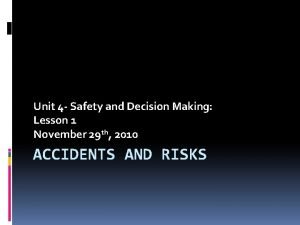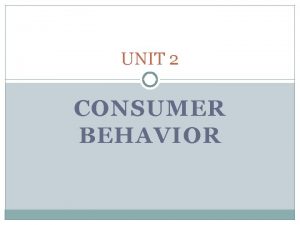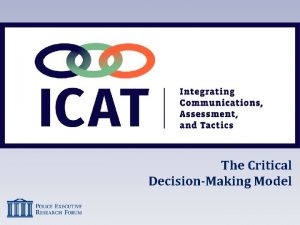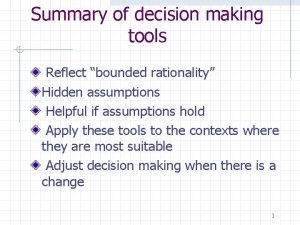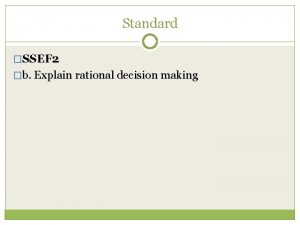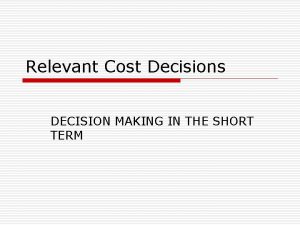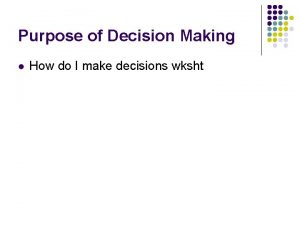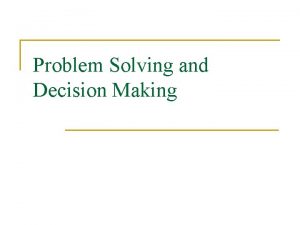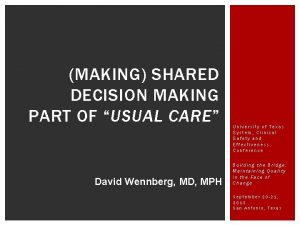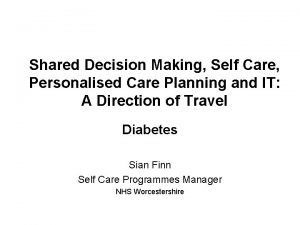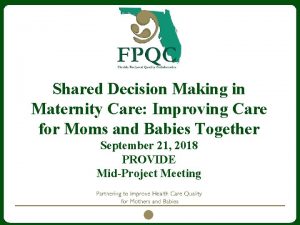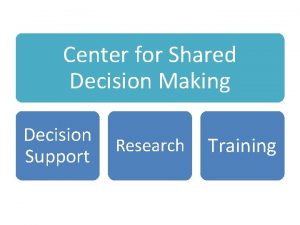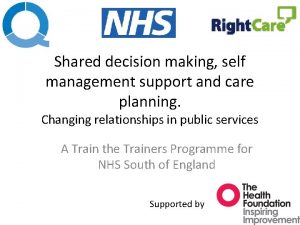MAKING SHARED DECISION MAKING PART OF USUAL CARE























































- Slides: 55

(MAKING) SHARED DECISION MAKING PART OF “USUAL CARE” David Wennberg, MD, MPH University of Texas System, Clinical Safety and Effectiveness Conference Building the Bridge: Maintaining Quality in the Face of Change September 20 -21, 2012 San Antonio, Texas

DISCLOSURE Health Dialog sells population health management products and services, including those to support shared decision making. I receive royalties from Health Dialog. This presentation includes data from a peer reviewed RCT that Health Dialog supported.

WHAT WE WILL COVER Profile of the issue Are physicians and patients on the same page? Is there evidence that doing the right thing can result in doing well? Making shared decision making part of usual care

PROVIDERS’ PERSPECTIVE (or at least it should be…) “healthcare that establishes a partnership among practitioners, patients and their families (when appropriate) to ensure that decisions reflect patients’ wants, needs and preferences and that patients have the education and support they need to make decisions and participate in their own care. ”

PROFILE OF THE ISSUE… Preference Sensitive Care § Care for conditions where treatment options exist § Where the treatment options involve significant tradeoffs in the patient’s quality or length of life § The choice of treatment should be decided upon by the fully informed patient in partnership with their physician (shared decision making) Source: A. M. O’Connor et al. Modifying Unwarranted Variations in Health Care: Shared Decision Making Using Patient Decision Aids. Health Affairs, Vol. 7, October 2004.

PROFILE OF THE ISSUE… Preference Sensitive Care Conditions (PSC) include: § Herniated disc (meds, PT, surgery) § Osteoarthritis (meds, surgery) § Coronary artery disease (meds, angioplasty/stenting, CABG) § Prostate cancer (active surveillance, radiation, surgery) § Early-stage breast cancer treatment (lumpectomy/radiation, mastectomy +/- reconstruction) § Benign uterine conditions (meds, D&C, ablation, hysterectomy) § Obesity (behavior change, meds, bariatric surgery) § End of life care (‘curative/futile’, palliative, hospice, etc) § Depression (meds, psychotherapy, watchful waiting) § Etc.

PRINCIPAL ASSUMPTIONS Patients want to be fully informed Informed patients will participate in shared decision making Fully informed physicians will honor patients’ values and preferences Patients are more risk averse than are their physicians

PROFILE OF THE ISSUE… “…Among those with severe arthritis, no more than 15% were definitely willing to undergo (joint replacement), emphasizing the importance of considering both patients’ preference and surgical indications in evaluating need and appropriateness of rates of surgery” Source: Hawker, G. A. , et al. Determining the Need for Hip and Knee Arthroplasty: The Role of Clinical Severity and Patients’ Preference. Medical Care. Vol 39(3), 206 -16.

PHYSICIAN’S DECISION-MAKING ROLE PREFERENCES Preferences Number of Providers (n=1050) Preferred to share decision-making with their patients 780 (75%) Preferred paternalism 142 (14%) Preferred consumerism 118 (11%) Perceived themselves as practicing their preferred style 87% Source: Murray E, Pollack L, White M, Lo B. Clinical decision-making: physicians’ preferences and experiences. BMC Family Practice. 2007. 8: 10

PATIENT’S DECISION-MAKING ROLE PREFERENCES Preferences Number of Patients (n=914) “I prefer to leave all the decisions regarding my treatment to my doctor. ” 102 (11. 1%) “I prefer that my doctor make the final decision about which treatment will be used, but seriously consider my opinion. ” 225 (24. 6%) “I prefer that my doctor and I share responsibility for deciding which treatment is best for me. ” 400 (43. 7%) “I prefer to make the final selection of my treatments after seriously considering my doctor’s opinion. ” 167 (18. 2%) “I prefer to make the final decision about the treatment I will receive. ” 20 (2. 1%) Source: Shields CG, et al. Decision-Making Role Preferences of Patients Receiving Adjuvant Cancer Treatment: A University of Rochester Cancer Center Community Clinical Oncology Program. Supportive Cancer Therapy. Jan 2004. Vol 1. No 2. 119 -126.

PROFILE OF THE ISSUE… 21. 0 Cardiac Revascularization 18. 0 15. 0 12. 0 9. 0 6. 0 3. 0 Ontario Benchmark

“INFORMED” CONSENT? In a survey of consecutive patients scheduled for an elective coronary revascularization procedure at Yale New Haven Hospital in 1997 -1998 § 75% believed PCI would help improve an MI § 71% believed PCI would help them live longer § <50% could name 1 possible complication of PCI § 85% were “consented” just before the procedure (by a fellow or an NP) Source: Holmboe ES. JGIM 2000; 15: 632.

PATIENTS’ AND CARDIOLOGISTS’ PERCEPTIONS OF PCI BENEFITS Anticipated Benefit Source: Rothberg MB, et al. Patients’ and cardiologists’ perceptions of the benefits of percutaneous coronary intervention for stable coronary disease. Ann Intern Med. 2010; 153: 307 -313.

PROFILE OF THE ISSUE… Reliance on delegated decision making § Presumes physicians adequately assesses patient’s values and preferences Failure to adequately inform patients of their treatment options § Options have varied risks and benefits that only the patient can experience Failure to adequately engage patients in informed choice § Leads to interventions (and costs) that fully informed patients would choose not to have

PROFILE OF THE ISSUE… Estimated proportion of health care spend by category of care Effective Care Preference Sensitive Care 12% Supply Sensitive Care 25% 63% Source: Dartmouth Atlas

WHAT WE WILL COVER Profile of the issue Are physicians and patients on the same page? Is there evidence that doing the right thing can result in doing well? Making shared decision making part of usual care

DECISIONS STUDY PAPERS

THE NATIONAL SURVEY OF MEDICAL DECISIONS ( a. k. a. DECISIONS Study) Telephone survey 3, 010 Americans > 40 years old § National, representative sample § Asked about 9 common medical decisions Defined a medical decision as § Having taken a medical action (such as screened for cancer, initiated medication, had surgery) within 2 years § Or having discussed taking such action with a health care provider in the last 2 years

DECISIONS STUDY Prevalence of Medical Decisions in Past Two Years 90% 83% Proportion of Population 80% 70% 60% 49% 50% 41% 40% 30% 21% 20% 26% 12% 8% 10% 0% High Blood Pressure High Depression Colon Cancer Breast Cholesterol Cancer (F) Medication Initiation Prostate Cancer (M) Cancer Screening Type of Decisions Cataract 5% 5% Knee/Hip Lower Back Replacement Pain Elective Surgery

DECISIONS STUDY Proportion of Population “Some” or “A Lot” of Discussion of Pros and Cons 100% 90% 80% 70% 60% 50% 40% 30% 20% 10% 0% 90% 83% 82% 79% 75% 73% 76% 69% 72% 62% 49% 31% 34% 39% 33% 14% High Blood Pressure High Depression Colon Cancer Breast Cholesterol Cancer (F) Medication Initiation Pros Cons 16% 13% Prostate Cancer (M) Cancer Screening Type of Discussion Cataract Knee/Hip Lower Back Replacement Pain Elective Surgery

DECISIONS STUDY Physician Offered an Opinion, Asked Patient’s Opinion Proportion of Population 90% 85% 84% 80% 78% 74% 80% 85% 77% 70% 82% 76% 78% 61% 60% 50% 41% 46% 45% 40% 34% 38% 30% Offered Opinion 20% Asked Opinion 10% 0% High Blood Pressure High Depression Colon Cancer Breast Cholesterol Cancer (F) Medication Initiation Prostate Cancer (M) Cancer Screening Type of Discussion Cataract Knee/Hip Lower Back Replacement Pain Elective Surgery

DECISIONS STUDY Proportion Mean proportion of knowledge items answered correctly 1. 00 0. 90 0. 80 0. 70 0. 60 0. 50 0. 40 0. 30 0. 20 0. 10 - 0. 70 0. 50 0. 40 0. 30 0. 20 High Blood Pressure High Depression Colon Cancer Breast Cholesterol Cancer (F) Medication Initiation Prostate Cancer (M) Cancer Screening Type of Discussion 0. 20 Cataract Knee/Hip Lower Back Replacement Pain Elective Surgery

HOW DO INFORMED PATIENTS FEEL? On a scale of 0 -10, where 0 is not at all informed and 10 is extremely wellinformed, how informed do you feel about your decision about (screening, medication, surgery)? Proportion of Population 40 36. 35 35 22% 30 41% 25 22. 11 20 15 10. 94 9. 53 8. 28 5. 35 1. 28 0. 72 1. 35 2. 34 1. 76 1 2 3 4 0 0 Not at all informed 5 6 7 8 9 10 Extremely well informed

DECISIONS STUDY Mean Rating (0 -10) Importance of Information Sources 10 9 8 7 6 5 4 3 2 1 0 8. 8 All Patients 8. 7 Internet Users Only 7. 4 6. 1 6. 4 4. 9 5 2. 1 HCP Internet* Family & Friends Media Information Source * 0 rating assigned to non-users

DECISION QUALITY INSTRUMENTS Preference Sensitive Decisions § What is the core sent of information relevant for each decision? § What are the most salient goals and concerns upon which patients select treatments? Mailed survey to determine accuracy, importance and completeness of items § How important was each item? § Pick top three Patient responses (n=324; 72 -85% by site) Provider responses (n=266; 76% response rate) Source: Lee C, Barry M, Cosenza C, Dominik R, Mulley A, O'Connor A and Sepucha K. Development of instruments to measure the quality of breast cancer Treatment decisions. Health Expectations 2010 Sep; 13(3): 258 -72 [Epub 2010 Jun 9]. Lee C, Hultman S, Sepucha K. Do patients and providers agree about the most important facts and goals for breast reconstruction decisions? " Annals of Plastic Surgery 2010 May; 64(5): 563 -6.

BRIDGING PERSPECTIVES: WHAT ARE THE KEY FACTS? Mastectomy SURVIVAL: COSMETICS: RECURRENCE: RADIATION: ADD. SURGERY: Lumpectomy Same Lose breast Keep breast Low (1 -5%) Slightly higher(5 -15%) Not Common 6+ weeks Rare Common (20 -50%) Source: Lee C, Barry M, Cosenza C, Dominik R, Mulley A, O'Connor A and Sepucha K. Development of instruments to measure the quality of breast cancer Treatment decisions. Health Expectations 2010 Sep; 13(3): 258 -72 [Epub 2010 Jun 9]. Lee C, Hultman S, Sepucha K. Do patients and providers agree about the most important facts and goals for breast reconstruction decisions? " Annals of Plastic Surgery 2010 May; 64(5): 563 -6.

TOP 3 THINGS PATIENTS SHOULD KNOW Benefits and harms from the survey about chemo and hormone therapy for breast cancer Fact % top 3 Patients % top 3 Providers Chemotherapy reduces recurrence, increases survival 12% 38% Hormone therapy reduces recurrence, increases survival 12% 33% Chemotherapy common side effects 12% 0% Chemotherapy serious side effects 24% 0% Hormone therapy common side effects 6% 0% Hormone therapy serious side effects 6% 0% Source: Lee C, Barry M, Cosenza C, Dominik R, Mulley A, O'Connor A and Sepucha K. Development of instruments to measure the quality of breast cancer Treatment decisions. Health Expectations 2010 Sep; 13(3): 258 -72 [Epub 2010 Jun 9]. Lee C, Hultman S, Sepucha K. Do patients and providers agree about the most important facts and goals for breast reconstruction decisions? " Annals of Plastic Surgery 2010 May; 64(5): 563 -6.

TOP 3 GOALS AND CONCERNS FOR BREAST CANCER DECISIONS Fact Goal/Concern Surgery: Keep your breast % top 3 Patients % top 3 Providers p 7% 71% <0. 01 Reconstruction: Look natural without clothes 59% 80% 0. 05 Chemotherapy: Live as long as possible 33% 96% 0. 01 Reconstruction: Avoid using prosthesis 33% 0% <0. 01 Source: Lee C, Barry M, Cosenza C, Dominik R, Mulley A, O'Connor A and Sepucha K. Development of instruments to measure the quality of breast cancer Treatment decisions. Health Expectations 2010 Sep; 13(3): 258 -72 [Epub 2010 Jun 9]. Lee C, Hultman S, Sepucha K. Do patients and providers agree about the most important facts and goals for breast reconstruction decisions? " Annals of Plastic Surgery 2010 May; 64(5): 563 -6.

IS DOING WHAT THE DOCTOR THINKS IS BEST A TOP PRIORITY? Decision % top 3 Patients % top 3 Providers p BCA surgery 86% 14% <0. 01 Hip placement 84% 40% <0. 01 Knee replacement 78% 35% <0. 01 Menopause 60% 21% 0. 02 PSA 59% 21% 0. 03 Spinal Stenosis 46% 5% <0. 01 Source: Lee C, Barry M, Cosenza C, Dominik R, Mulley A, O'Connor A and Sepucha K. Development of instruments to measure the quality of breast cancer Treatment decisions. Health Expectations 2010 Sep; 13(3): 258 -72 [Epub 2010 Jun 9]. Lee C, Hultman S, Sepucha K. Do patients and providers agree about the most important facts and goals for breast reconstruction decisions? " Annals of Plastic Surgery 2010 May; 64(5): 563 -6.

KEY DIFFERENCES AND CONCLUSIONS Patients feel it is critical to do whatever the doctor thinks is best Patients and providers focus on different issues Delegation of information provision and decision making to providers is problematic § Likely to not get information want and need § Likely to not get treatments that best match their individual goals and concerns Source: Lee C, Barry M, Cosenza C, Dominik R, Mulley A, O'Connor A and Sepucha K. Development of instruments to measure the quality of breast cancer Treatment decisions. Health Expectations 2010 Sep; 13(3): 258 -72 [Epub 2010 Jun 9]. Lee C, Hultman S, Sepucha K. Do patients and providers agree about the most important facts and goals for breast reconstruction decisions? " Annals of Plastic Surgery 2010 May; 64(5): 563 -6.

WHAT WE WILL COVER Profile of the issue Are physicians and patients on the same page? Is there evidence that doing the right thing can result in doing well? Making shared decision making part of usual care

SHARED DECISION-MAKING (SDM) Definition: Integrative process between patient and clinician that § Engages the patient in decision-making § Provides patient with information about alternative treatments (often includes a decision aid) § Facilities the incorporation of patient preferences and values into the medical plan Source: Charles C, Soc Sci Med 1997; 44: 681

SDM: CAN IT EFFECT CHOICE? Use of decision aids show that fully informed patients choose differently than non-informed patients Cardiac Revascularization (1994 -95) 21. 0 18. 0 15. 0 12. 0 9. 0 6. 0 Ontario Benchmark 3. 0

SDM: CAN IT EFFECT CHOICE? Revascularization Decision in Ontario * Controls Stable Angina SDM Video *RR=0. 77, p=0. 01 Source: Morgan MW, et al. , JGIM. 2000; 15: 685 -93

SDM: CAN IT EFFECT CHOICE? Summary measure of surgery versus medical management across the 8 trials RR (95% CI) = 0. 75 (0. 60 -0. 94) Source: O’Connor AM. , et al. Decision aids for people facing health treatment or screening decisions. Cochrane Database of Systemic Reviews

SDM: CAN IT EFFECT CHOICE? Review of 86 RCTs in use of decision aids § Greater knowledge of options, benefits and harms § More realistic expectations § Lower decisional conflict related to feeling uninformed § Less uncertainty related to lack of clarity on personal values § 40% fewer people who were passive in decision Decisions differ from usual care § 25% § 30% § 20% § 14% reduction in elective invasive surgery reduction in use of menopausal hormones reduction in PSA testing for prostate cancer increase in screening for colon cancer Source: O’Connor, Cochrane Review, 2006.

SDM: CAN IT ALSO REDUCE COSTS? RCT of over 174, 000 people Identify individuals at risk for unwarranted utilization Navigation and Shared Decision-Making support Outcomes: cost and utilization at 1 year Source: Wennberg DE, Marr A, Lang L, O’Malley S, Bennett GB. A Randomized Trial of a Telephone Care-Management Strategy N Eng J Med 2010; 363: 1245 -55

SDM: CAN IT ALSO REDUCE COSTS? Medical cost differences by service category Avg. Monthly Cost Difference (Enhanced – Usual Support) $0. 00 -$10. 00 -$0. 02 -$5. 96 -$7. 96 Other; 17% -$15. 96 -$20. 00 -$30. 00 PSC; 21% -$40. 00 Chronic 62% -$50. 00 -$51. 12 -$60. 00 Total Population Chronic Conditions Preference-Sensitive Condition Other High-Risk Condition All Others Service Category Source: Wennberg DE, Marr A, Lang L, O’Malley S, Bennett GB. A Randomized Trial of a Telephone Care-Management Strategy. N Eng J Med 2010; 363: 1245 -55

SDM: CAN IT ALSO REDUCE COSTS? Medical cost differences by service category Most of the cost reduction was due to reduced inpatient and outpatient hospital costs $1. 00 Avg. Monthly Cost Difference (Enhanced – Usual Support) $0. 00 -$0. 05 -$1. 00 -$0. 78 -$2. 00 -$1. 61 -$3. 00 13. 3% reduction in high variation medical admissions -$4. 00 11. 5% reduction in preferencesensitive admissions -$5. 00 -$6. 00 -$7. 00 $0. 52 -$6. 04 Inpatient Hospital Emergency Room Outpatient Hospital Outpatient Office Pharmacy Service Category Source: Wennberg DE, Marr A, Lang L, O’Malley S, Bennett GB. A Randomized Trial of a Telephone Care-Management Strategy. N Eng J Med 2010; 363: 1245 -55

SDM: CAN IT ALSO REDUCE COSTS? Observational study to examine association between introducing decision aids for hip and knee osteoarthritis and rates of joint replacement surgery and costs in a large health system Source: Arterburn, Wellman, Westbrook, et al. Introducing Decision Aids at Group Health was Linked to Sharply Lower Hip and Knee Surgery Rates and Costs. Health Affairs, 31. no. 9 (2012): 2094 -2104

ASSOCIATION BETWEEN DECISION AIDS AND SURGERY 26% 38% 26% reduction in 180 -day rate of hip replacement surgery 38% reduction in 180 -day rate of knee replacement surgery Hip Knee Source: Arterburn, Wellman, Westbrook, et al. Introducing Decision Aids at Group Health was Linked to Sharply Lower Hip and Knee Surgery Rates and Costs. Health Affairs, 31. no. 9 (2012): 2094 -2104

ASSOCIATION BETWEEN DECISION AIDS AND COSTS 21% 12% 21% reduction in costs in the hip replacement cohort 12% reduction in costs in the knee replacement cohort Hip Knee Source: Arterburn, Wellman, Westbrook, et al. Introducing Decision Aids at Group Health was Linked to Sharply Lower Hip and Knee Surgery Rates and Costs. Health Affairs, 31. no. 9 (2012): 2094 -2104

WHAT WE WILL COVER Profile of the issue Are physicians and patients on the same page? Is there evidence that doing the right thing can result in doing well? Making shared decision making part of usual care

ADOPTION OF SHARED DECISION-MAKING ON A LARGE SCALE Reasons: § Ethical imperative to do the “right thing” § Move from (flawed) informed consent to informed choice § Aligning preferences and values with an individual’s clinical decision § Bridge health disparities § Conservative utilization of surgical interventions

RHODE ISLAND HOSPITAL PERFORMED SURGERY ON WRONG PART FOR 5 TH TIME The Rhode Island Department of Health is investigating Rhode Island Hospital in Providence after the hospital admitted to operating on the wrong body part for another patient, marking at least the fifth wrong-site surgery at the hospital since 2007. Source: About. Law. Suits. com, Oct 30, 2009.

PATIENT SAFETY Wrong Site Surgery Wrong Patient Surgery How do we describe operating on a patient who would say NO to surgery if alternatives, risks and benefits were well understood?

LEGISLATIVE PUSH FOR SHARED DECISION-MAKING Source: Kuehn BM. States Explore Shared Decision Making. (Reprinted) JAMA 24, 2002. Vol 301. No 24, p 2539.

PAYMENT REFORM FOR SHARED DECISION-MAKING Medicare Program; Medicare Shared Savings Program: Accountable Care Organization

WHO’S DOING SDM AS PART OF USUAL CARE? Not too many places…. Dartmouth-Hitchcock Health FIMDM demonstrations Group Health

4 STEP PROCESS OF SHARED DECISIONMAKING Define the population Engage the patient (include a decision aid if available) Provide support § Patient understands treatment options § Patient has thought about options within context of preferences and values Clinical discussion

SDM PROCESS PSC ELECTIVE SURGERY Patient identified via diagnosis or at time of referral Patient Decision No: Do not refer; explore non-surgical options Engage: appropriate for surgery? Yes, or unknown: Prior to specialist visit, send decision aid to patient 1 week before visit, confirm that DA was used; offer decision support Patient not interested in surgery; inform PCP Patient leaning towards surgery Patient undecided CONSULT: Patient and surgeon review DA info and make decision

GEOGRAPHIC APPROACH Mission : Provide products and services that enable members to deliver high quality, efficient care and to support them in delivering outcomes of care based on the Triple-Aim as they move from fee for service reimbursement and volume based care to care financed by global budgets and full capitation Guiding Principles : v Patient-centered care v Transition to capitation v Common measures v Learning & innovation v Public-private partnerships v Transparency v Separate risk arrangements v Stewardship

BEYOND THE USUAL SUSPECTS: NEW QUALITY MEASURES Did the patient know a decision was being made? s. C on lue Va nt Decision Quality Did the provider elicit the patient’s preferences? me e olv co rda Inv nc e Did the patient know the pros and cons of the treatment options? Did the patient know what (s)he needed to know? Did the decision reflect the patient’s goals and concerns? Knowledge Source: Sepucha KR, et al. Policy support for patient-centered care: the need for measurable improvements in decision quality. Health Affairs (Millwood). 2004; Suppl Web Exclusives: VAR 54 -62.

LINING UP ALL OF THE LEVERS Establish informed patient choice as the standard of care § Ethically required § Replace informed consent with informed patient choice § Legal structures that mirror clinical model Reimbursement changes § Support infrastructures to systemically deliver shared decision making § Pay for achieving high quality patient decision making Benefit changes § Incentives to participate in shared decision making § Cost sharing for more expensive intervention?

WHAT WE WILL COVER Profile of the issue Are physicians and patients on the same page? Is there evidence that doing the right thing can result in doing well? Making shared decision making part of usual care
 Hoy tarter model
Hoy tarter model Prsb shared decision making
Prsb shared decision making Lung cancer screening shared decision making tool
Lung cancer screening shared decision making tool No decision snap decision responsible decision
No decision snap decision responsible decision Financial decision
Financial decision When atticus speaks of defending tom
When atticus speaks of defending tom When cell division does not occur in the usual pattern
When cell division does not occur in the usual pattern Escenario bau
Escenario bau 8z em linguagem usual
8z em linguagem usual The usual suspects font
The usual suspects font Usual phrases
Usual phrases Levels of nursing care primary secondary tertiary
Levels of nursing care primary secondary tertiary Shared goals of care
Shared goals of care Decision tree and decision table examples
Decision tree and decision table examples Distribution decisions in marketing
Distribution decisions in marketing Four sales channels
Four sales channels Youth involvement
Youth involvement Reamers ethical decision making model
Reamers ethical decision making model Systematic decision making process
Systematic decision making process Paced decision making
Paced decision making Mamdm
Mamdm Using recursion in models and decision making sheet 3
Using recursion in models and decision making sheet 3 Defining moments
Defining moments Unit 4 lesson 1 decision making
Unit 4 lesson 1 decision making Decision making unit example
Decision making unit example Types of decision making
Types of decision making Corporate culture higher business
Corporate culture higher business Contribution payoff table
Contribution payoff table Unstructured decision making
Unstructured decision making Role of marketing research in decision making
Role of marketing research in decision making Critical decision making model police
Critical decision making model police Contoh soal pohon keputusan dan jawabannya
Contoh soal pohon keputusan dan jawabannya Tactical decision making
Tactical decision making What is the dare decision making model
What is the dare decision making model Decision making summary
Decision making summary Mintzberg's modes of strategic decision making
Mintzberg's modes of strategic decision making Paced decision making
Paced decision making Chapter 6 prices and decision making assessment answers
Chapter 6 prices and decision making assessment answers Decision making conditions
Decision making conditions Sbdm roles and responsibilities
Sbdm roles and responsibilities Decision making and relevant information
Decision making and relevant information 5 step decision making process
5 step decision making process Building blocks of quality
Building blocks of quality Abcde decision making model
Abcde decision making model Decision making in psychology
Decision making in psychology Best books on problem solving and decision making
Best books on problem solving and decision making Individual and group decision making
Individual and group decision making What graphical model is appropriate for decision making
What graphical model is appropriate for decision making Nature of decision making
Nature of decision making Habitual decision making adalah
Habitual decision making adalah Laney todd
Laney todd Paced decision model
Paced decision model Stop method moral decision making
Stop method moral decision making Consumer decision making process
Consumer decision making process Types of decision making
Types of decision making Types of decision making in management
Types of decision making in management

